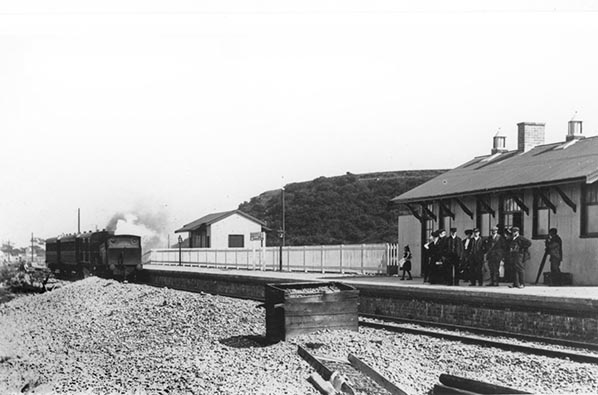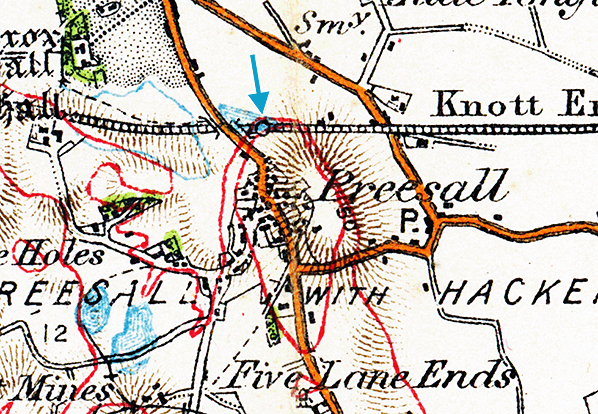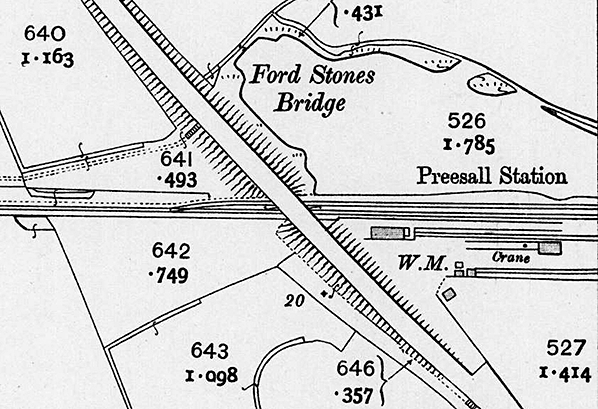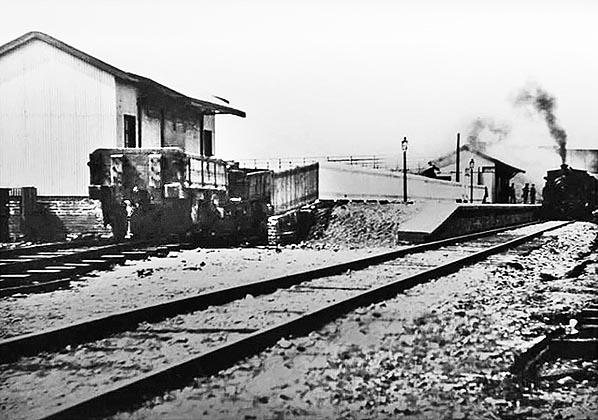Notes: Opened by the Knott End Railway (KER) on 29 July 1908 Preesall station was situated on the 11 mile 29 chain single track Garstang and Knott End branch line a short distance to the north of its namesake. A railway from the London & North Western Railway’s (LNWR) west coast trunk route, at Garstang & Catterall, had been opened to Pilling (1½ miles east of Preesall) by the Garstang & Knot (sic) End Railway (G&KER) on 5 December 1870. The line had struggled financially and had gone into receivership in 1878. It was never able to raise the capital to extend to Knot End. On 12 August 1898 the KER was formed to build the line from Pilling to Knott End. The new company also had financial difficulties as well as a legal dispute with its contractor and it took them 10 years to build the 4½ mile line. On 1 July 1908 the KER had purchased the G&KER route.
 Preesall station was located on the east side of Park Lane which passed over the railway by means of a bridge. A single platform, with a brick face, was provided on the south side of the line. Preesall station was located on the east side of Park Lane which passed over the railway by means of a bridge. A single platform, with a brick face, was provided on the south side of the line.
Passenger facilities were located in a single storey timber building. At the time of opening there was no passing loop but one was added soon after. No platform was provided on the north side of the loop so it was not used for the purpose of allowing passenger trains to pass.
Goods facilities were provided at Preesall. There was a goods yard, located to the south of the passenger facilities, which had two sidings. Just beyond the east end of the passenger platform there was a goods shed with loading ramp. A lifting crane and weighbridge was also provided.
From the start the KER had seen the tourism of the Fylde Coast as an important source of traffic and during the summer months they operated an intensive train service which was promoted extensively. A further source of traffic for the line was the opening of a 1½ mile branch line from a point ¾ mile to the west of the station to the salt works of the United Alkali Company. The salt traffic was invoiced from Preesall station.
A local company had been running motor bus services between Knott End and Pilling (one of the favoured visitor attractions of the area) since 1909 and as the buses went into the centre of the village they took many passengers away from the railway. In 1920 the KER hired a railmotor from the LNWR to supplement its summer services and to better compete with the buses. During the winter the railmotor started to operate all of the passenger services (click here to see the KER line on a quarter inch scale map from 1920).
The July timetable for 1922 showed seven trains in each direction Monday-to-Saturday.
In 1922 the line was used by 77,579 passengers and it carried 69,535 tons of goods. The total revenue for that year was £12,815 against an expenditure of £11,583.

On 1 July 1923 the KER was absorbed into the London Midland & Scottish Railway (LMS). The LMS continued to use the railmotor for most of the passenger services.
During the 1920s competition from buses intensified and passenger services became uneconomic.
On 31 March 1930 the LMS withdrew the passenger services from the line. Preesall station remained open for goods until 13 November 1950 by which time it had passed into the ownership of British Railways. The line through Preesall (between Knott End and Pilling) was closed on the same day and was lifted sometime after 1953.
After closure the station building were demolished but the platform was extant in 2010.
CLICK HERE FOR A DETAILED HISTORY OF PREESALL STATION
Route map by Alan Young
Sources:
- Awdry, C British railway companies (Guild Publishing,1990)
- Clinker, C R Clinker’s register of closed passenger stations and goods depots in England, Scotland and Wales 1830-1977 (Avon-Anglia,1978)
- Cobb, M H The Railways of Great Britain – vol.1 (Third Edition) (Author, 2015)
- Holt, G O A Regional History of the Railways of Great Britain – vol.10 (David & Charles, 1978)
- Quick, Michael Railway passenger stations in Great Britain - a chronology (RCHS, 2009 and on-line supplements)
- Richardson, D The Pilling Pig - A History of the Garstang and Knott End Railway (Cumbrian Railways Association, 2019)
To see the
other closed of the Knott End Branch
click on the station name: Garstang & Catterall, Garstang Town, Nateby, Cogie Hill, Cockerham Cross, Garstang Road, Pilling, Carr Lane and Knott End
Click here to see Register of Closed Railways 1901 - 1994 |

 Preesall station looking east in 1908 shortly after the station had opened. The large deposits of ballast seen in the foreground are adjent to the gravel pit that was excavated out by the construction contractor Robert Worthington. The pit was just to the left of the photograph and had been purchased by the contactor specifically for the purpose of providing ballast.
Preesall station looking east in 1908 shortly after the station had opened. The large deposits of ballast seen in the foreground are adjent to the gravel pit that was excavated out by the construction contractor Robert Worthington. The pit was just to the left of the photograph and had been purchased by the contactor specifically for the purpose of providing ballast.

 A view of Preesall station looking west in 1908. The station goods shed can be seen to the left.
A view of Preesall station looking west in 1908. The station goods shed can be seen to the left. Preesall station was located on the east side of Park Lane which passed over the railway by means of a bridge. A single platform, with a brick face, was provided on the south side of the line.
Preesall station was located on the east side of Park Lane which passed over the railway by means of a bridge. A single platform, with a brick face, was provided on the south side of the line.
 Looking east at the Preesall station site in September 1989.
Looking east at the Preesall station site in September 1989.
 Home Page
Home Page